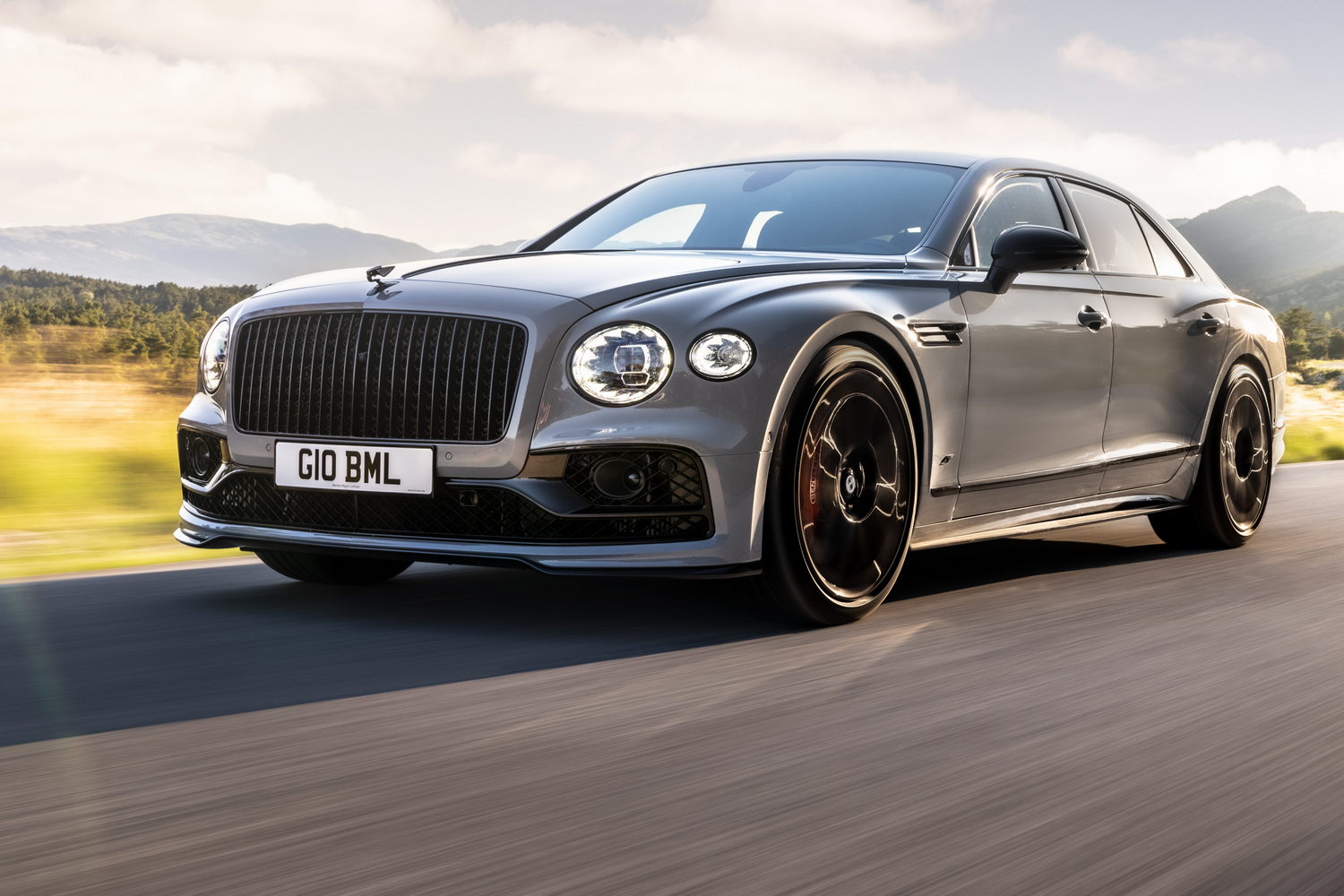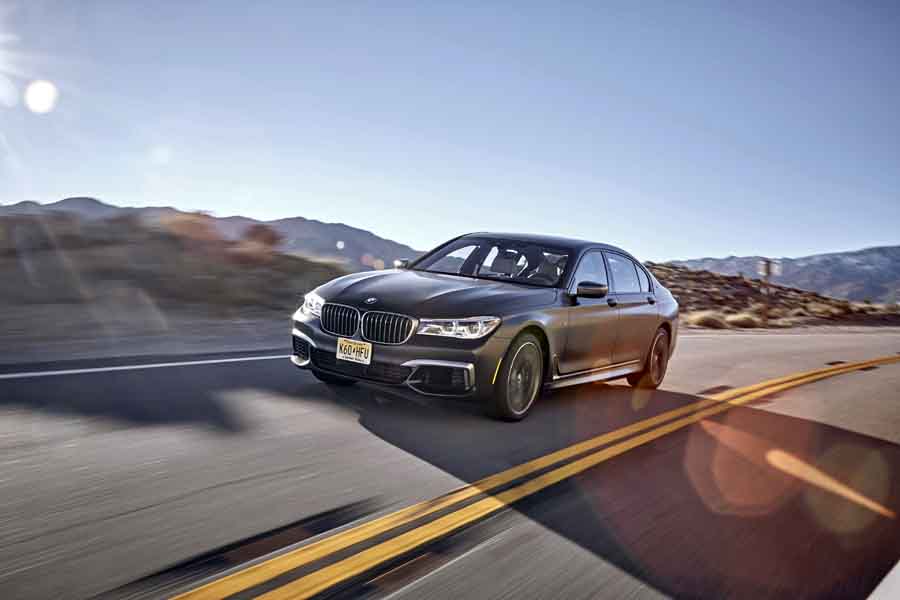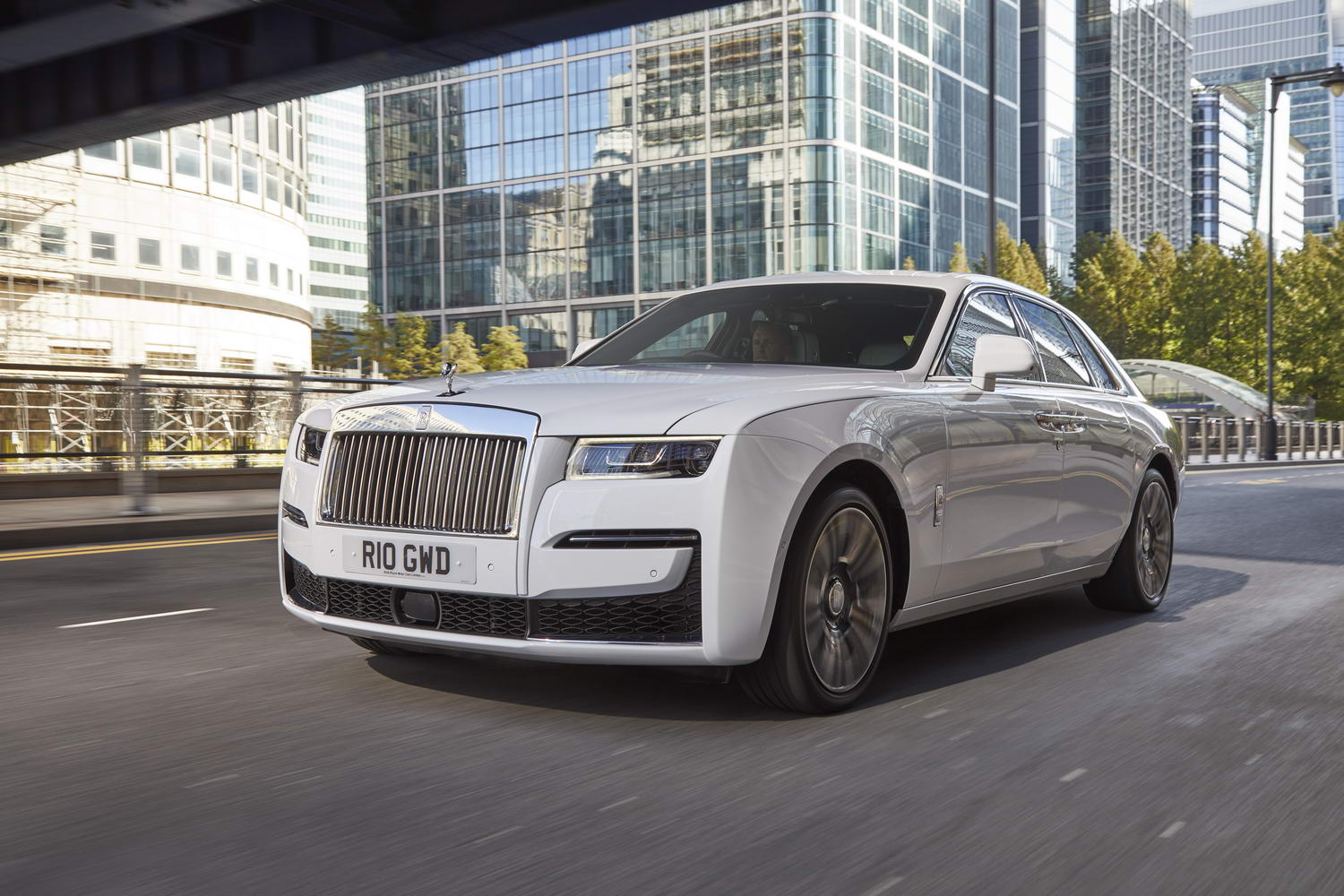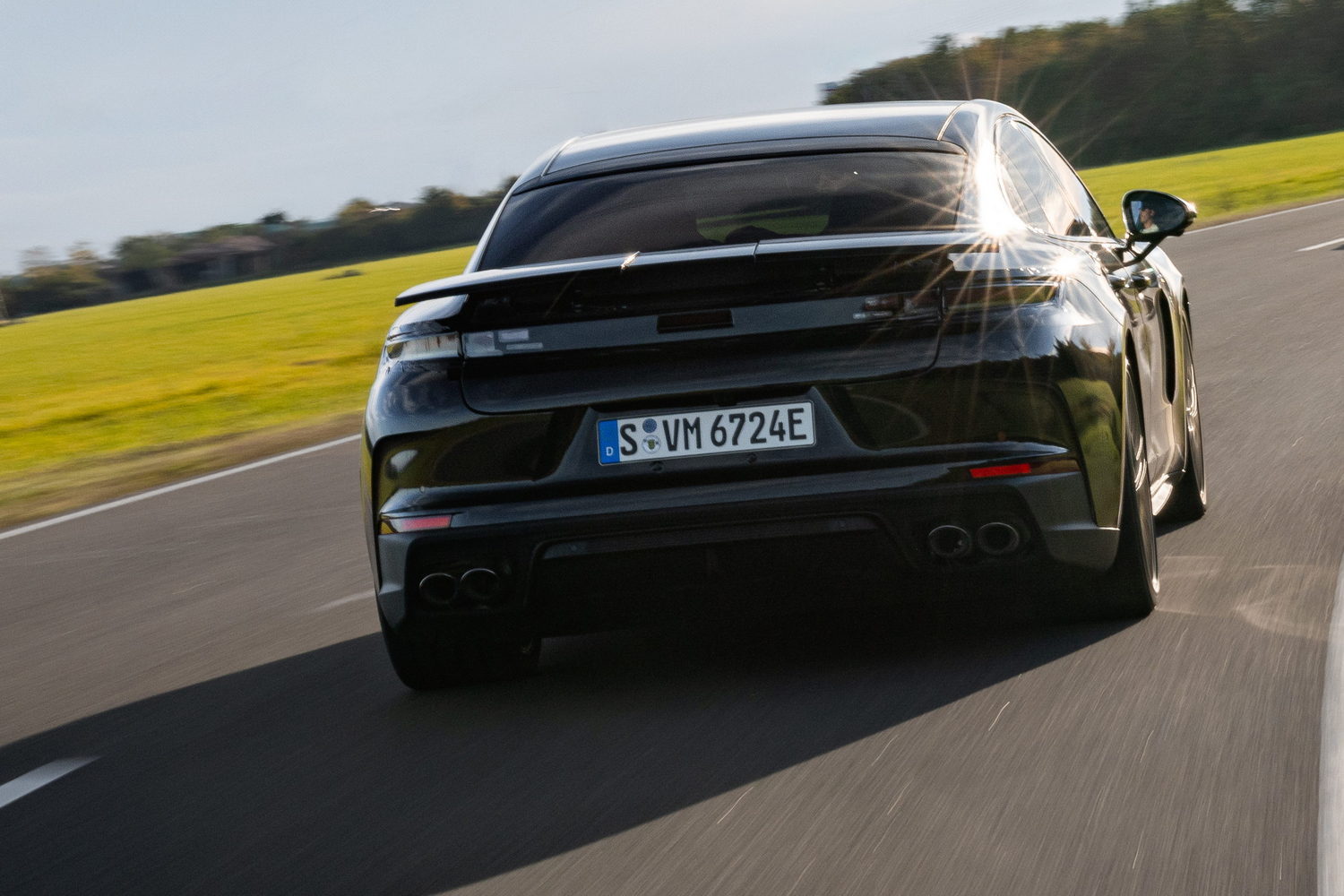The idea of a sporty Bentley Flying Spur is, on paper, a little preposterous. Here's a massive, two-and-a-bit-tonne lump of pomp and circumstance that's trying to put itself in running shoes. But the truth is that the Flying Spur, even in its most aristocratic (i.e. heavy) guises, is no slouch. So does the more aggressive, more dynamically minded Flying Spur really make sense? Or should it stick to being a big, luxurious limousine?
In the metal
The Flying Spur is nothing if not imposing, and though it may not have the frontal area of the Bentley Bentayga, it still manages to ooze menace and power. Even if it is in a decidedly old-school kind of way. There's a sort of gangster rakishness to the long body, muscular flanks and low, long roofline, especially when it's paired with the glossy black trim that's standard on S versions.
In contrast with the chrome brightwork found elsewhere in the Flying Spur range, which gives the big Bentley saloon a kind of classic opulence, the black trim around the grille, windows and even the Flying B bonnet mascot gives the Flying Spur S some hot rod menace. It makes it feel more like the villain of the piece, hurtling from one evil plan to the next.
Inside, however, the S is as opulent as the next Flying Spur, with the same glorious materials and beautifully crafted cabin as anything else in the range. There are subtle differences, including the S badge on the passenger side of the dash and the use of microfibre upholstery, but otherwise it's pure Bentley luxury.
In terms of driving position, however, Bentley has managed to make this big saloon feel somewhat sporty. The Flying Spur cocoons you with its centre console and the band of wood veneer around the cabin, making you feel low and cosy in the driving seat. It's immensely comfortable, though, with lots of seat and steering wheel adjustment (electric, of course) and options for seat heating, ventilation and massaging. It is, in fact, every inch the luxury car.
Especially for every other occupant. Rear legroom is outstanding, rear headroom is more than adequate and you can even fit three across the rear seats, although the one in the middle won't be anything like as comfortable as the other two. Revert to four-seat occupancy, fold down the centre arm rest and the Flying Spur becomes the consummate luxury barge, ferrying all three passengers in supportive and adjustable seats, and there's even a little rear touchscreen that pops out to become a tablet and allows those in the back to access all the comfort settings they need.
Speaking of technology, the Flying Spur also gets Bentley's latest touchscreen in the dashboard up front, providing a responsive and easy-to-navigate system that's seamlessly integrated with the digital instrument display. And, if you want, you can have the central display housed in a rotating box that offers three different interior options. You can go for the full screen, you can have a blank piece of veneer, or you can go for our favourite - the three little classic dials.
Naturally, all these systems work beautifully, and everything feels as premium and as upmarket as you'd expect from something so expensive. Bentley clearly places great emphasis on quality, and everything from the hides to the wood veneer is checked for imperfections before being perfectly matched with its neighbours. At times, the technology used is less than extravagant - Bentley's upholsterers will sometimes use domestic irons to get the leather to fit perfectly - but the attention to detail is beyond question. And, of course, Bentley will allow customers to customise their vehicle to almost infinite levels.
Whatever you choose, you're getting a fantastically built luxury saloon, with every button and every piece of trim made from some of the best materials around. And stitched together perfectly. It's clear the British company has learned from its sibling firm Audi when it comes to cabin construction, and few vehicles feel as solid as the Flying Spur.
Few vehicles have as many buttons, either. We're all for physical controls over touchscreen menus, but the Flying Spur's centre console is riddled with switches. The rotary driving mode control feels like overkill, but it's well integrated with the ignition button, while the climate control switches are beautifully damped and integrated. It looks a bit messy, however, and it takes a bit of time to get used to where everything is. That's nit-picking in the extreme, mind you.
But while we're nit-picking, let's talk about boot space. The Flying Spur has clearly reserved most of its space for people, rather than their belongings, so the boot feels a bit small at 420 litres. You'll get more carrying capacity in the back of an Audi A8, for example. But at least this is the V8 version of the Flying Spur, and not the Hybrid. That's because the Hybrid has to make room for batteries and motors and other electric paraphernalia, and that cuts the boot space to 351 litres, which is less than you'll find in the back of a Volkswagen Golf. Stick with the V8, though, and you have enough space for a few suitcases and soft bags, which should do you for the time it takes to reach the yacht in Monaco.
Driving it
The Flying Spur S is offered with a choice of two different propulsion systems, but neither is necessarily an economy option - either in terms of price or consumption. Perhaps the greenest option is the Hybrid, which combines a V6 petrol engine with an electric motor and a rechargeable battery to create a 544hp plug-in hybrid system. Officially, it'll get from 0-100km/h in about four seconds and it'll manage 40km or so on electric power alone, allowing those who charge regularly to achieve semi-palatable economy figures.
But were we in the market for such a thing, the V8 tested here would be our choice. The 4.0-litre engine is used to great effect in other Bentley products, and the 550hp output is complemented by a crackling, snarling soundtrack that adds a bit of extra magic to whichever car it's installed in. Admittedly, the Flying Spur is the least dramatic application for this powerplant - it doesn't sound as aggressive as it does in a Bentley Continental GT, for example - but perhaps that's to be expected. And even so, it still has a lovely burble to it and it's significantly more exciting than the Hybrid's V6.
It isn't much faster with just 6hp more, but it still goes to all four wheels via an eight-speed automatic gearbox, allowing a 0-100km/h time of four seconds. You don't really need to go any faster than that. But despite that, the Flying Spur doesn't feel especially rapid. Perhaps it's the quietness or the smoothness, or even just the car's size, but it always feels like it's cantering, rather than fully extending itself. But if you're just tickling the accelerator pedal, the feeling of effortlessness is extraordinarily satisfying. As is the refinement, which means though the engine can get vocal when you want it to, it can be quiet at times as well.
Less satisfying is the fuel consumption, which isn't exactly going to keep Greenpeace onside. If you manage to burn fewer than 13 litres of unleaded over 100km, you have the patience of a saint and the deft right foot of a ballerina. We'd enjoy the sound and performance too much to be on anything other than first name terms with our local petrol station staff.
Incredibly, considering the Flying Spur weighs well over two tonnes before you fill it with people and fuel, there's more to it than just conspicuous consumption and straight-line speed. The steering is inherited from the Continental GT, which means it's little short of exquisite, and though the Flying Spur can never hide its weight, it does a solid job of keeping the bulk in check, as long as you steer clear of Comfort mode. In Sport mode, on the other hand, body roll is minimal and the response from the front wheels is immediate, which instils plenty of confidence. Combine that with the massive tyres, all-wheel-drive traction and surprisingly precise balance, and the Flying Spur is a much better car to drive than you might expect. Especially in S V8 form, which gets all-wheel steering for better manoeuvrability and stability.
Incredibly, the Flying Spur manages to balance this performance with a surprisingly smooth ride. Sure, opting for Comfort mode slackens things to the point at which the body follows the wheels more lethargically, but it means you get better isolation from the lumps and bumps. Not that the Flying Spur is exactly firm in Sport mode.
Even with the car in its most aggressive settings, it can soak up the imperfections in the road surface pretty well, but Comfort mode allows it to become the magnificent cruiser you expect a Flying Spur to be. It's hardly a Jekyll-and-Hyde shift in character, but the way the Flying Spur glides along motorways is mighty impressive.
There is, however, one criticism of the Flying Spur from which we must not shy. While its handling is startling for something so big, the way in which it stops leaves something to be desired. We were hoping the V8 version of the Spur would, like the V8 Continental GT, feel much more agile and light on its feet than the flagship 6.0-litre W12, but that just isn't the case. Yes, it's better in corners, but when you hit the brakes, it still feels as though it's struggling to slow down such an immensely bulky saloon car. It isn't disastrous - with a bit of forward planning it's no trouble at all - but we would have liked more powerful brakes.
What you get for your money
With no Bentley dealer in the Republic of Ireland, buyers will have to head for Belfast or over the Irish Channel to the rest of the UK if they want to import a Flying Spur. Either way, you'll need bucketloads of cash. Charles Hurst Bentley in Belfast reckon it'll cost about €400,000 registered in Ireland. As a value proposition, then, it's hard to make the case for the Flying Spur, although it's worth bearing in mind that Hybrid versions will incur far less tax than the V8 tested here thanks to their lower emissions ratings.
Summary
Reasons to overlook the Bentley Flying Spur S are plentiful. We aren't great fans of the black trim, and the idea of a sporty Flying Spur seems a little silly, particularly when the standard car is hardly slow. But somehow the S works, particularly with this V8 engine, which makes it feel a little more agile. It isn't the rip-roaring success it is in the Continental GT, but this S version of the Spur certainly makes a case for itself. And a strong one at that.














